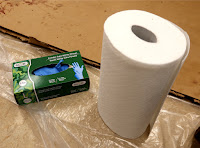3045 Army Cadet Corps held its first Parents Night Parade of the 2024-2025 Training Year on October 23. It was a great opportunity to invite parents, guardians, friends, & community members and show them what the cadets had achieved since the start of the year.
The cadets & I arrived at Inuujaq School’s gym an hour before the start of the parade to set everything up. The setup has been standard since I became commanding officer. We line one whole wall with chairs, two flags, and an awards table. The Royal Regiment flag is taped to the opposite wall and a line of chairs for cadets sits underneath it. The reception table, filled with snacks, and drinks sits in a far corner. On the wall near the exit doors, cadets tape informative posters about the cadet program and results from marksmanship & physical fitness training. I also include pictures of past cadet events. The cadets changed into their green dress uniforms once everything was ready. Doors opened at 6:15pm. The parade started at 6:30pm.
I recruited & trained a teacher to be the Guest Reviewing Officer (GRO). I marched in first and the GRO followed. We both received the General Salute. The cadet parade commander introduced himself and then escorted the GRO through the ranks for inspection. I briefly spoke to the audience while this was happening, welcoming them to the parade, and introducing the GRO. The cadets then did a March Past for everyone.
The
GRO gave a brief congratulatory speech to the cadets for looking good in their
uniforms and marching in unison. He also
thanked me for giving him the opportunity to participate.
The parade continued with the presentation of badges, awards, and promotions. Marksmanship badges were the first on the list. The corps runs a marksmanship program throughout the year on weekends where cadets shoot air pellet rifles at paper targets. Badges are awarded based on accuracy. There are 4 levels: Level 1 is the lowest & Level 4 is the highest. This time, one cadet received a Level 1, six cadets received Level 2, two cadets received Level 3, and three cadets received Level 4. It’s very impressive to achieve Level 4 so quickly. The real challenge is maintaining that level of skill for the remainder of the year. Each cadet received their badge and had their picture taken with the GRO.
I announced the eight cadets who were selected for this year’s biathlon team and instructed them to come to the front to be publicly recognized. I held a tryout competition last month and selected 4 junior cadets & 4 senior cadets based on the highest scores. The competition will take place early next year.
A
cadet who attended summer camp at Whitehorse had an article written about them
in Nunavut News. I called them up to the
front to receive a laminated copy of the article and to congratulate them for
successfully completing the course.
The next four awards were from the Annual Ceremonial Review (ACR) Parade in May, but I called the recipients again to place their engraved name plates on the plaques & trophies. They also had their pictures taken again with the awards. The four awards are: Most Improved Cadet, Best Boots & Deportment, Top Female & Male Athletes, and Top Cadet. I order the name plates much later because when selecting cadets, I review everything up until the ACR, so it’s too late to order & receive the name plates before the actual parade.
The last part of the presentations were promotions. There were five promotions this time. Three corporals were promoted to the rank of master-corporal, a senior-junior rank, if that makes sense. One master-corporal cadet was promoted to the rank of sergeant, a junior-senior rank. And one master warrant officer (MWO) was promoted to the highest rank of the cadet program, chief warrant officer (CWO). This was probably the highlight of the parade because it’s been many years since 3045 had a CWO. The size of the corps usually determines if a CWO is needed. The choice was between two MWOs.
In my closing remarks, I thanked the corps sponsors, the audience for attending & supporting the corps, the teacher for being the GRO, and the cadets for putting on a good show. I also made a few announcements on what’s coming up for the cadets.
The
newly promoted cadet CWO led the cadets in the Advance In Review Order and
General Salute. I marched out of the gym
with the GRO following behind me. The
cadets were then dismissed.
The
cadets & I moved to the back of the gym for a group photo. We then moved on to reception. Reception lasted about 30 minutes. The cadets & I then cleaned up the gym
& put everything away. I held a
quick debriefing with the cadets before letting the CWO dismiss them for the
night.












.jpg)





